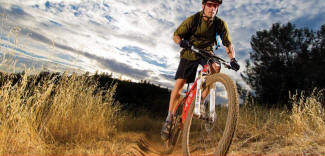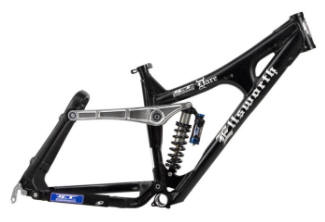Hardtail vs. Full-Suspension
Which is Right for You?
original article by Matt Brady on 21 September, 2008
The battle of the hardtail and the full- suspension
is the stuff of legend. It is a burning question of both newbies and seasoned
riders: Forum flame-wars are started at the mere mention of it. Everybody
has the friend that swears a hardtail is the only way to go if you want
to climb, and another that tells you there’s no way but the full-suspension
way. So what is the difference really?
suspension
is the stuff of legend. It is a burning question of both newbies and seasoned
riders: Forum flame-wars are started at the mere mention of it. Everybody
has the friend that swears a hardtail is the only way to go if you want
to climb, and another that tells you there’s no way but the full-suspension
way. So what is the difference really?
The battle is changing constantly. Bikes have progressed greatly since the fore-fathers of mountain biking created the sport back in the 1950’s. Today new materials, designs, and fabrication techniques flood the market from an immense source of innovative manufacturers. Back in the day when the full-suspension bike was a new idea, it was heavy, cumbersome, slow, and inefficient; today many of those original stigmas are history. Nevertheless the hardtail still has a strong foothold in the market and for good reason.
Let’s Break it Down:

The Details:
That should give you a basic overview, but let’s look at this in a little more detail. The weight factor can be an issue with the full-suspension vs. hardtail battle, however with today’s technologies, several sub 20lb. fulls exist, if you are willing to dish out the cash. Dollar for dollar you will commonly get a hardtail that is a few (2-5) pounds lighter than a full-suspension. Now you may be asking yourself, how much does a couple pounds actually matter? The honest answer is it depends on what you are doing. A lighter bike will lend an advantage to climbing as well as a small advantage to handling (the lighter weight allows easier control and quicker response). A couple pounds can make a bit of difference, but it is not the only thing to consider.
Agility is better on a hardtail because of a typically shorter wheel base, lighter total weight, and stiff rear end. If you are looking for a bike that has a fast handling response a hardtail might be the answer, but don’t decide yet. When it comes to handling in technical situations, with lots of loose rock and other obstacles, full-suspensions excel. Good technique can get you through a lot of tough terrain on a hardtail, but you may come to situations where you just aren’t going to make it through. The full-suspension not only absorbs the impacts of obstacles but allows for more traction to be transferred to the ground on technical terrain. This means that although hardtails are better climbers in smoother terrain, in severely rocky terrain a good cross-country full-suspension will far outperform it.
 In
the beginnings of the full-suspension bike maintenance was a big issue.
With today’s technology many of the problems with seals, bad bushing/bearings
and breakage are gone. On a full-suspension you have a rear shock and pivots
in addition to all of the normal components. The shocks of today rarely
fail when adjusted properly. The worst you will see is a failing seal, and
that should only occur after many years of use. The pivots can sometimes
trap dirt and water and creak as the rear triangle moves. By taking these
pivots apart and regreasing the problem is easily remedied. Nevertheless
it can still be a nuisance, and some frame designs are more susceptible
to this than others.
In
the beginnings of the full-suspension bike maintenance was a big issue.
With today’s technology many of the problems with seals, bad bushing/bearings
and breakage are gone. On a full-suspension you have a rear shock and pivots
in addition to all of the normal components. The shocks of today rarely
fail when adjusted properly. The worst you will see is a failing seal, and
that should only occur after many years of use. The pivots can sometimes
trap dirt and water and creak as the rear triangle moves. By taking these
pivots apart and regreasing the problem is easily remedied. Nevertheless
it can still be a nuisance, and some frame designs are more susceptible
to this than others.
The general rule of thumb is the more technical the terrain the more travel you need, but always take the time to consider your personal riding style. I am a hardtail fanatic, yet I still take on technically challenging trails. There are times on the trail when I wish I was on a full, yet I love the tight handling and speed that only a hardtail can deliver. It is the difference between driving a rally car or an off-road masher. Each has benefits and costs. Pick the one that is best for your situation. Find a good bike shop near you that can let you feel the differences in each option. There are many choices out there, with numerous suspension designs, travel options and frame materials. A good bike shop is the best guide.
Happy trails!
- copied from MTO Bikes' website - used with permission